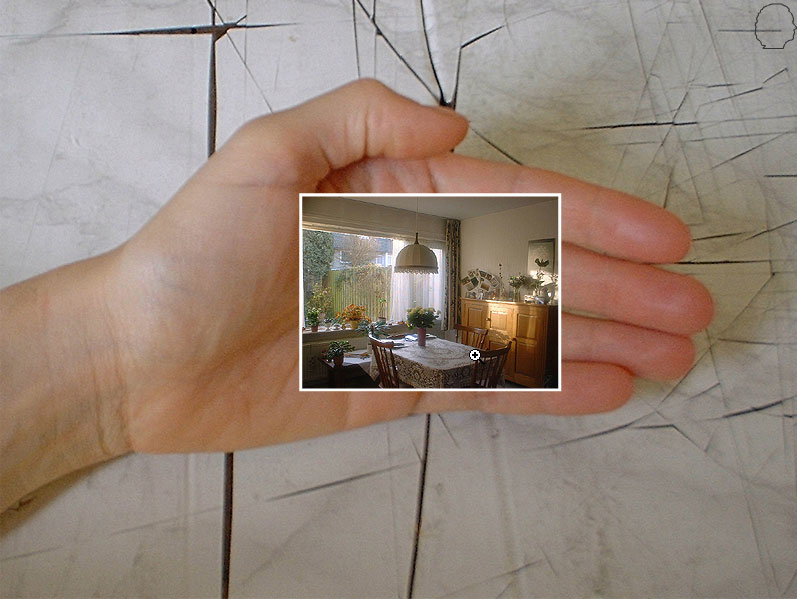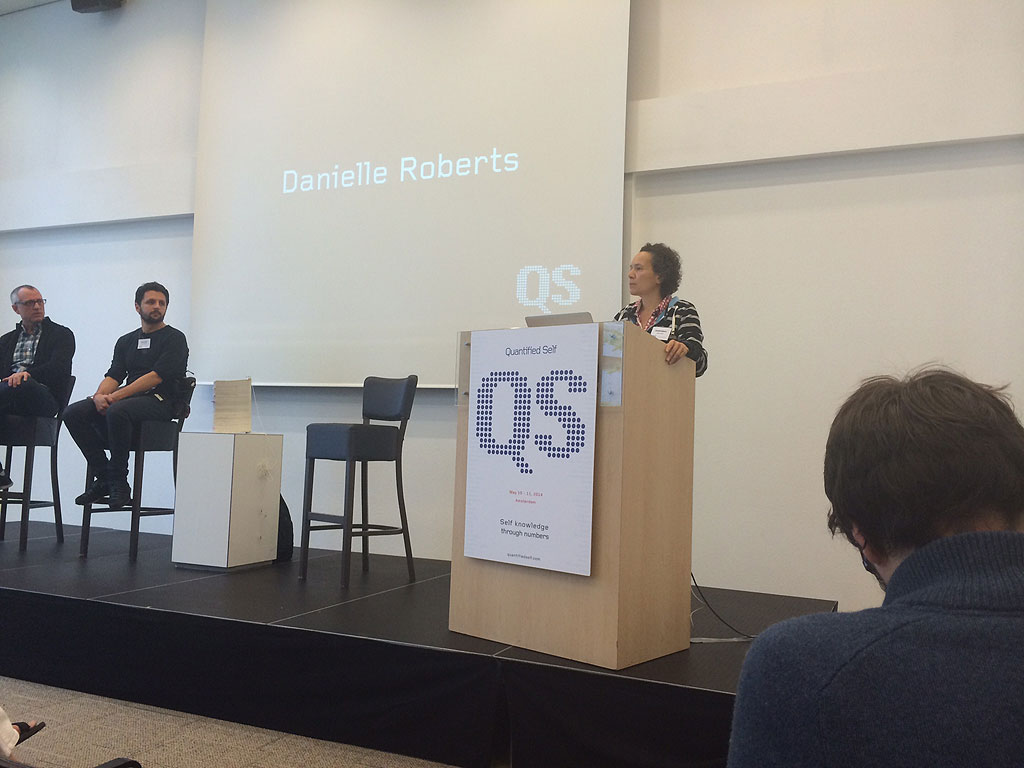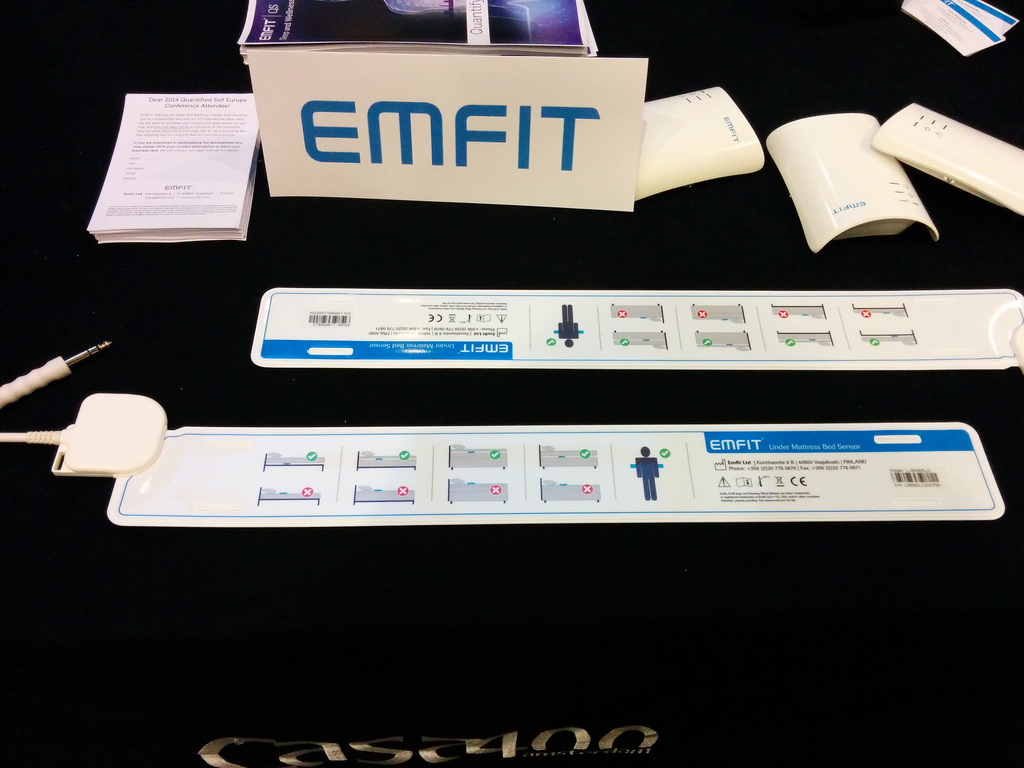For the third time I’ve visited the Quantified Self Europe conference in Amsterdam. I had been looking forward to it but was also a bit nervous because I was asked to take part in a panel discussion on Sunday morning. I felt very honoured of course to have been asked to talk about my Reversed calendar project which I finished last year. The discussion topic was on long term tracking. Apparently it is not something a lot of people have done. We got a lot of questions and hardly any experiences from the audience. The talk went well and it was nice to hear the other speakers. Especially Alberto is quite a die-hard, logging the most crazy things. He’s also an artist and it is interesting to see the different approach artists take on collecting data about themselves. The starting point that you use your personal data as material to make stuff is so different from other approaches. The goal is not to improve but to become aware and study yourself through the collecting, more then through the actual interpretation of the data.
Here’s what I did:
Grief and Mood Tracking (Breakout session)
Whitney Erin Boesel, Dana Greenfield
What happens when you’re tracking, but not looking to change you how feel? Join us to discuss the ways we can use different techniques to work through the process of loss and grief.
Dana gave a very moving and inspiring opening talk about how she is tracking the memory of her mother who passed away recently. She used simple tools like a Google form and pictures to log things that reminded her of her mother. I’d already decided before that I’d like to join this breakout as I’ve made a cd-rom about the death and remembrance of my mother and my grieving process back in 2001.

Someone suggested that it would be interesting to track how the grieving network around you changed as time moved on. For me the reason to make this cd was partly because of a lack of network…
The question came up if someone had experienced grieving with and without tracking. I was in the unfortunate position to have experienced both. I was quite a discovery for me that the making of an art-piece was much more helpful in the grieving process than just tracking my mood. The latter was just a conformation of my sadness while in the art making process I could transform this into something beautiful that I could share.
Ignite Talks
Washing My Eyelids
Steve Dean
Steve will demonstrate how he used self-tracking tools to get under atopic dermatitis.
Tracking his eyelid inflammation was useful to him in talking to his doctor but didn’t yield any insights on its own. This was an interesting talk because of the frustrating process Steve was tracking and the way he kept going in spite of the lack of results.
Analyzing Changes in My Weight and Sleep
Kouris Kalligas
Kouris spent thirty hours combining his multiple data streams into one place, and learned what influenced his weight and sleep.
What was interesting for me here was the thoroughness with which Kouris had looked for correlations between the things he tracked. He also made a list of expected findings at the beginning of his quest and compared these with the outcomes of his analyses. One finding intrigued me: higher fat percentage during the day led to a better sleep. I think that might have to do with feeling more satiated And therefore eating earlier. I’m going to do a little experiment myself on the correlation of food and beverage intake and working late and sleep quality (view below).
Fit 50s Sound 60s
Maria Benet
Maria has been tracking for almost 10 years, developing strategies for improving and maintaining her health as she ages.
I really enjoyed this talk by Maria. First of all because she’s not your usual QS suspect. I found it very refreshing to hear a story by someone who step by step discovered self tracking because she wanted to lose weight and become fit again. Here was this somewhat older lady talking about all these apps and devices with a lot knowledge from experience. I liked the Excel sheet in which she manually annotated and combined different measurements go gain more insight. A quote from Maria that I wrote down: Small habits add up to a big impact in the long run.
A Testosterone and Diet Experiment
Maximilian Gotzler
Blood tests showed Max he had low levels of Vitamin D and Testosterone. Could diet changes help?
What I liked about this talk was the thoroughness with which Maximilian tried to tackle his deficiencies. He had all kinds of blood test done which I didn’t know existed. Would I be able to afford them?
Photo Lifelogging as Context for QS Practice
Cathal Gurrin, Niclas Johansson, Rami Albatal
Learn how to use computer vision to extract metadata from lifelogging photos, enrich a photo timeline with other personal data, and draw insights from massive longitudinal photo collections.
I’ve been thinking a lot about easy food logging and behaviour tracking through pictures. I would make my life so much easier if these things could be automated. So I was really happy when I read this was a topic of one of the breakout sessions. It was a very interesting but sobering talk. No way am I going to write my own program or app to log my food or extract activity from a picture. It takes the experts a _very_ long time to write classification algorithms for every object. It all has to be annotated by human hand.
But fortunately they are open to collaboration. I think automated food and calorie logging will be very big. So I offered to work on the annotating if it can eventually lead me to my food being logged with the right amount of calories while I eat! They were also interested in my behaviour tagged pictures from the north-southfeeling project. So if they’re helpful I’m happy to share them.
Sensing Smell
Jenny Tillotson
Scent has the power to profoundly affect our psychology and physiology. Learn about the state of the art in smell tracking, interpretation, and use.
Smell is something I’ve been interested in for a long time. I’ve used it in the AQAb wearable of course. But for me personally smell is also very important. Jenny is a designer of wearables who is really deep into everything about smell. She’s working on a device that can reduce stress and improve sleep through scent. Being an academic she has the opportunity to work with lots of experts in the field, I envy that sometimes. As an artist you have to do so much on your own.
A lot of aspects about scent and smell still remain a mystery. Digitalising scent is still far of. I asked her about enhancing meditation with scent. She said there’s an interest in that lately, in the realm of mindfulness and she will e-mail some pointers on where to start with that. Great!
Neuroscience & EEG
Martin Sona
This was an unplanned breakout session with neuroscientist Martin Sona on the latest developments in devices and applications for the QS community.
Martin is a really nice and accessible guy. I knew he had a lot of knowledge on open source EEG but I had no clue he was a neuroscientist working as a researcher at the university of Maastricht.
I’ve been looking for an easy way to capture brain data. I was very enthusiastic about the TrueSense wearable bio-sensor kit that was at the QS conference last year. But I couldn’t really work with it because I couldn’t figure out how to get to the live data and it was very hard to interpret the streams. Martin has been collaborating with them and made some patch in BrainBay an open source Bio- and Neurofeedback Application that can be used with the TrueSense kit. Wow, looking forward to trying that out. Martin is looking for ways to be able to place the sensor at different sides of the head. I will look into that for him. I want to integrate it in a wearable anyway.
On top of all these inspiring talks and exchanges I was lucky to make contact with a lot of people. Some from companies, some just participants, some I’d met before others new. There’s a lot of time to talk to people and the insights you get from them and hopefully give to others is just so rewarding.
And I’ve done an ‘impulse’ purchase. It wasn’t really an impulse as I slept on it but for me it is quite something to buy something over a 100 Euro without weeks of deliberation. I’ve ordered an Emfit device. It’s a sleep tracker that can distinguish between different sleep phases and track heart- and breathing rates when you sleep. It can even do heart-rate variability. They’re working on a downloadable csv file of your data and an API. All data is send wireless from a non-contact device under your bed sheets. I’ve wanted a sleep tracker for years. Can’t wait to try it!
Finally there was quite a distinct buzz about empathy and including others in your tracking. Kaiton Williams gave an interesting opening speech where he mentioned tracking for empathy. I’ve always wanted to inspire and give to others with my tracking by transforming it into art. But I’m looking for ways to make it more concrete. Quite a few people came up to me to talk about the subject. I might even do something to improve animal well fare using the breathCatchers. It is good to see that others are also looking for ways to reach out and share more.
All in all a very, very inspiring and uplifting experience. I’m already looking forward to next year.


Leave a comment